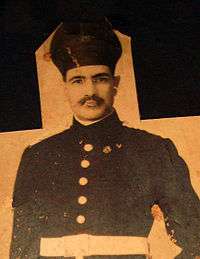Nawab Alam Yar Jung Bahadur
Mir Alam Ali Khan, also known as Nawab Alam Yar Jung Bahadur, was an Indian judge and politician.[1]
Mir Alam Ali Khan Alam Yar Jung Bahadur | |
|---|---|
Alam Ali Khan | |
| Born | 23 April 1890 Hyderabad |
| Died | 25 Feb 1974 Hyderabad |
| Nationality | Indian |
| Alma mater | Nizam College Madras University Lincoln College, Oxford |
| Scientific career | |
| Fields | Law |
| Institutions | Courts of Hyderabad state . |
Early life and education

Alam Ali Khan was the eldest son of Mir Hashim Ali Khan. Nawab Hashim Nawaz Jung, a colonel with the Hyderabad Imperial Service Troops and Nizams regular Forces received education at Madrasa-e-aliya and the Nizam College, where he obtained both a B.A. and a B C L degrees. For a short period he served as a Cadet in the Army. Later, obtained his M.A from Madras University, subsequently, he moved to England to complete his education at Oxford University's Lincoln College here he attained his barrister-at-law and returned to Hyderabad. He died in 1974.
Civil service
Ali Khan was appointed Munsif-darj-e-awal (first session judge) for the court of Beerad and soon also became Nazim-Sardar-e-Adalat (inspecting officer) at the court of Gulbarga. For a long time he served as the inspecting officer for the courts of Andhra Pradesh, and was later appointed Nazim-e-Sardar (Chief Justice). On 2 August 1943, Alam ali khan was conferred the title Alam yar jung, the next day on 3 August the High court remained closed,in honour to felicitate and celebrate. After his retirement from his judicial offices, he was appointed as a Judicial and religious member of HEH the Nizams Executive council wherein he held the judicial portfolio.
Family
Nawab Alam yar jung had three brothers and four sisters. The brothers included Nawab Talib Ali Khan, Accountant General of Hyderabad, Col Subhan Ali Khan, also Barrister at law Mir Iqbal Ali Khan Barr-at-lae .[2] The sisters included Mehdi Begum, Tahira Begum and Wazir Begum.
Further reading
- Burton, Reginald George (1905). A history of the Hyderabad contingent. p. 34.
- Directory and Year Book including Who's Who. Vol. 32. The Times of India. 1945. p. 180.
- Jamil, S. M. (1948). The Muslim Year Book of India and Who's Who: with complete information on ... India. p. 87.
- All India Reporter. Vol. 4. 1956. p. 176.
- "Islamic culture". s. 19-20. Hyderabad: Islamic Culture Board. 1971: 82. ISSN 0021-1834. Cite journal requires
|journal=(help) - Reddy, Pingle Jaganmohan (1999). The judiciary I served. Hyderabad: Orient Longman. p. 11. ISBN 978-81-250-1617-5.
- Reddy, Pingle Jaganmohan (2000). Down memory lane: The revolutions I lived through. p. 238. ISBN 978-81-85194-57-8.
References
- Various (15 March 2007). Hyderabad State List of Leading Officials, Nobles and Personages. Potter Press. p. 4. ISBN 1-4067-3137-4.
- Jamil, S. M. (1948). The Muslim year book of India and who's who. Bombay Newspaper Company. p. 87. Retrieved 12 July 2009.